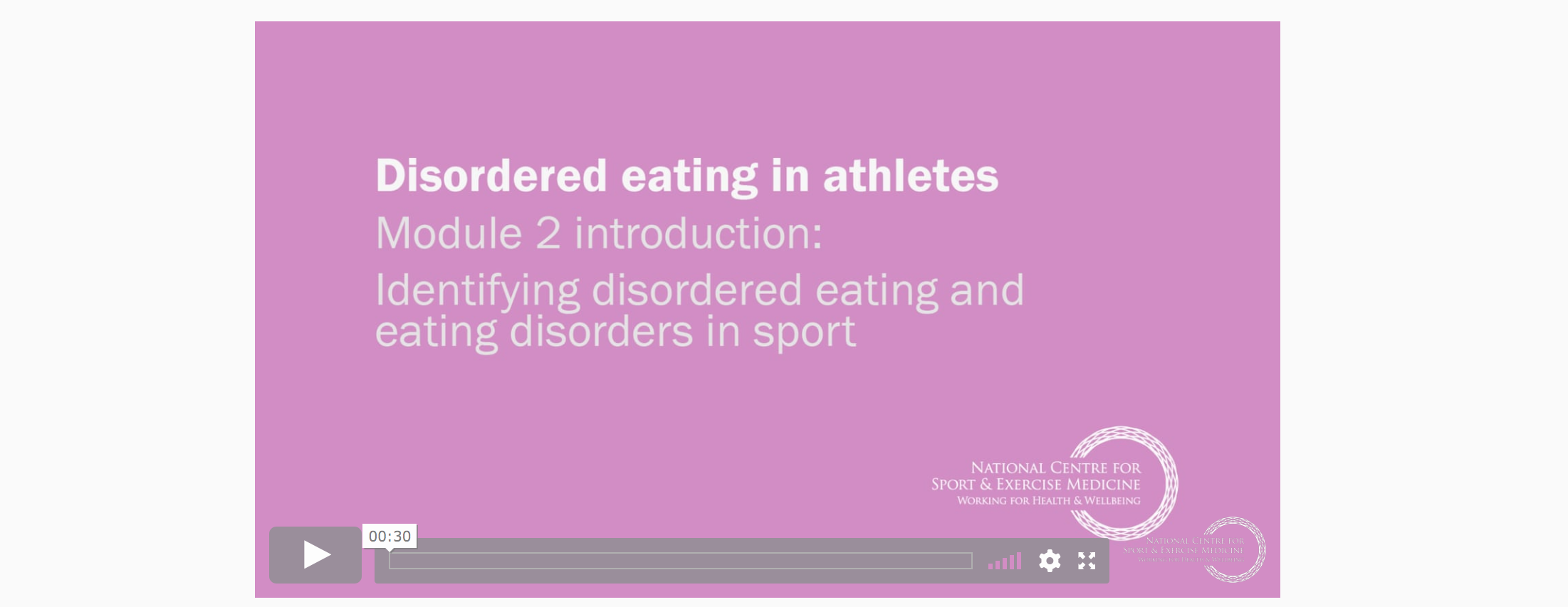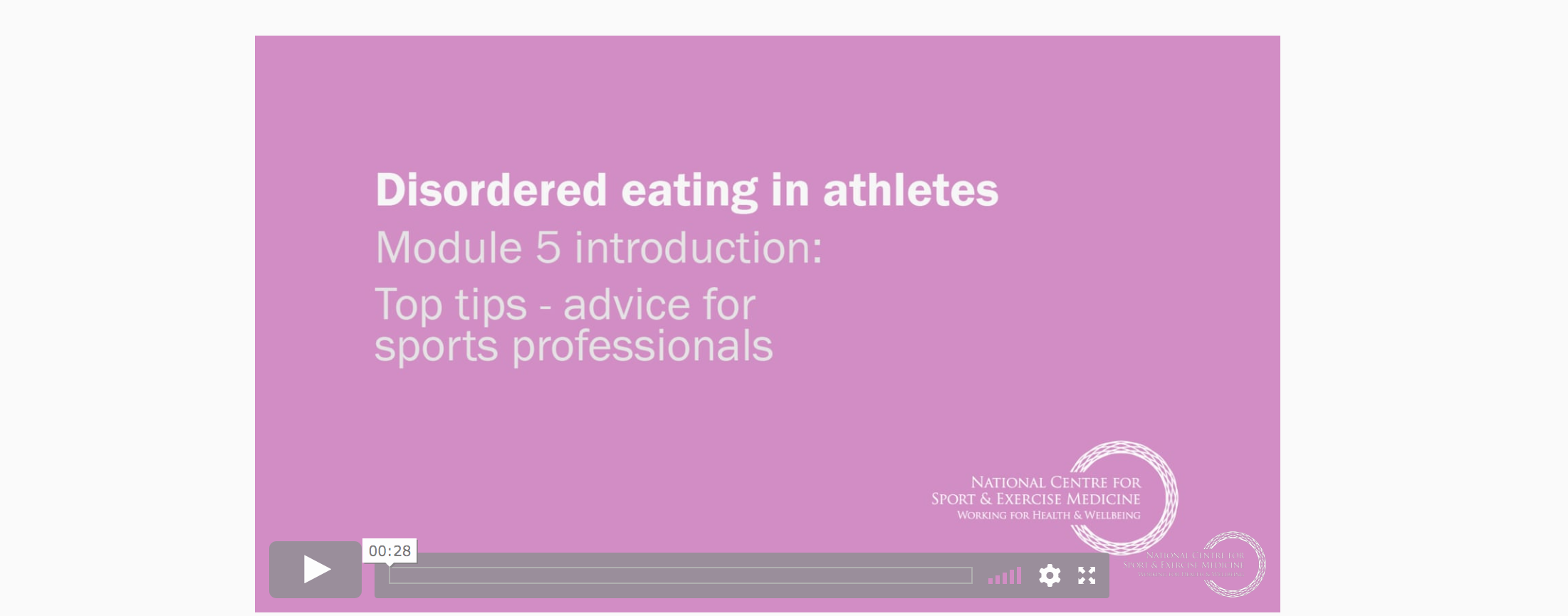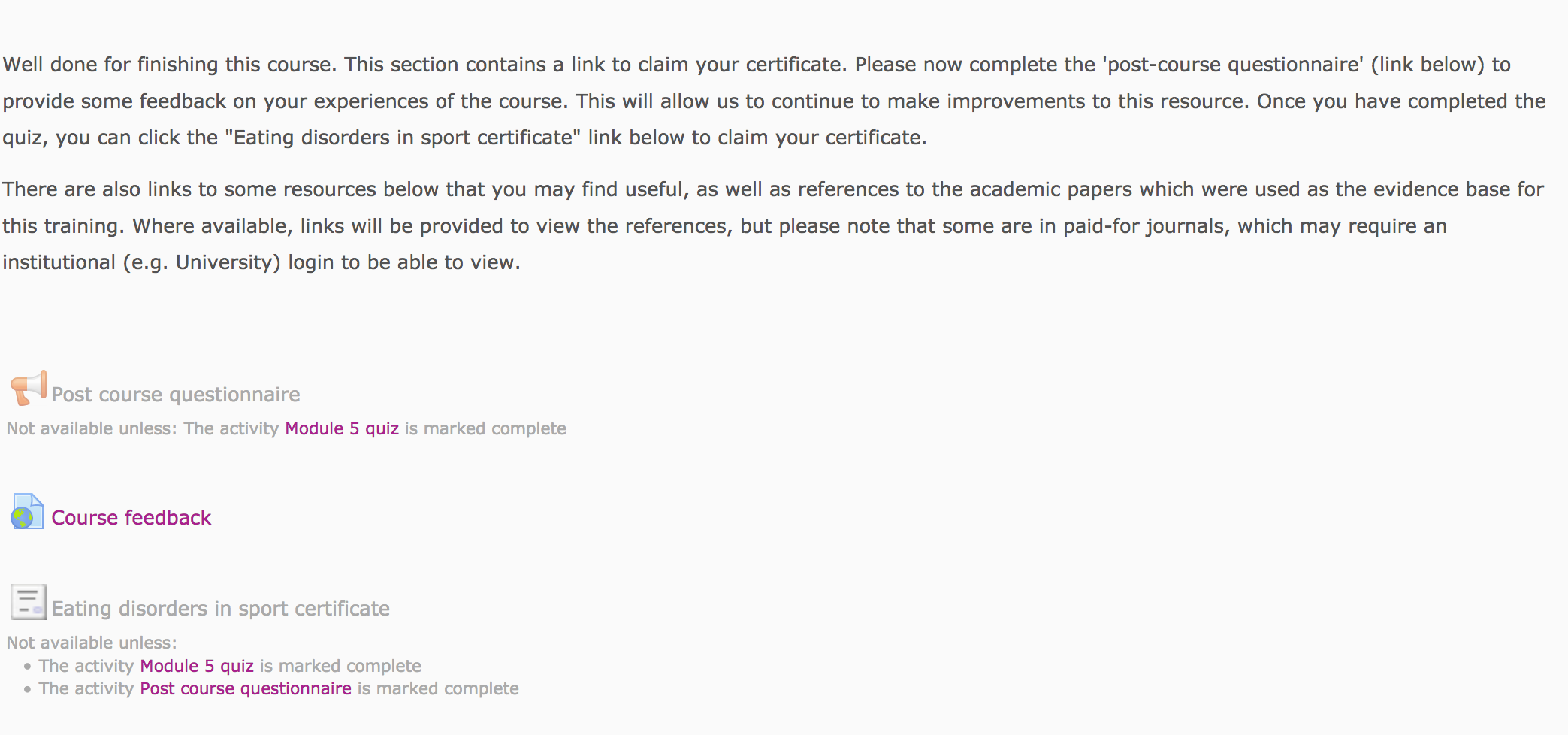Introduction

This section contains a brief introduction to the course, providing you with information about the topics that will be covered as well as the methods used to teach you these concepts.
The introduction also includes some pre-learning questions, which encourages you to reflect on how much you already know before starting the course. There is also a true or false quiz for to you to complete. Neither of these activities are assessed and the grade you obtain will not be used anywhere else within the course.
Module activities:
- Short video and text providing a course overview and methods of learning
- Reflective pre-learning questions
- True or false quiz
Module 1: What are eating disorders?
This module introduces you to the main categories of clinical eating disorders and the eating behaviour spectrum. We consider how athlete eating behaviour may be similar or different to the general population. The prevalence of eating issues among male and female athletes, and across different sports will be explored, and key risk factors for their development will be considered.
This module starts with an introductory video, followed by five pages and topics to work through. There are also two activities to complete. The first is the “Stop and Think” activity, which looks at the differences in eating attitudes and behaviours between athletes and the general population. Feedback on this reflective task is provided via a short video. At the end of the module there is also a short, summative quiz, which will assess your learning for Module 1.
Once you have completed these activities you will then be able to move onto Module 2, which focuses on identifying eating disorders and disordered eating among athletes.
In order to start Module 1, you must first have completed the pre-learning quiz in the Introduction section.
Module activities for module 1:
- Introductory video and module learning outcomes
- Reflective pre-learning quiz
- Page 1: Clinical Eating Disorders: text and diagrams
- Page 2: The Eating Spectrum: text and diagrams
- Page 3: Stop and Think: Interactive activity and reflective task; video feedback.
- Page 4: Prevalence of Eating Problems in Athletes: Text and diagrams
- Page 5: Risk factors for development page: Text and diagrams
- Summative quiz
Module 2: Identifying disordered eating among athletes

This module focuses on the impact of eating problems on athlete health and performance, and offers guidance around spotting the signs and symptoms of potential eating problems in your athletes. The module also discusses some of the challenges that coaches and sports professionals may encounter in identifying eating problems amongst their athletes.
The module starts with a brief introductory video and the module learning outcomes. This is then followed by six pages and topics to work through. There are also two activities to complete. The first is the “Stop and Think” activity, which is a reflective activity on the barriers and challenges to detecting potential eating problems among athletes. Feedback on this reflective task is provided via a short video. There is also a short, summative quiz at the end of the module.
Once you have completed these activities you will then be able to move onto Module 3, which focuses on how to approach an athlete with a suspected eating problem.
Module activities for module 2:
- Introductory video and module learning outcomes
- Page 1: The Female Athlete Triad: text and diagrams
- Page 2: Relative Energy Deficiency in Sport: text and diagrams
- Page 3: Signs and symptoms of eating issues: text and diagrams
- Page 4: Challenges to detecting potential eating issues: Video and text
- Page 5: Screening tools and when to use them: text
- Page 6: Stop and Think: Reflective activity and feedback video
- Summative quiz
Please note that in order to start module 2 you must have first completed module 1.
Module 3: Approaching an athlete with a suspected eating problem

This module explores how coaches and sports professionals can approach an athlete with a suspected eating problem, and explores some of the challenges and issues to be aware of when doing so.
The module starts with an introductory video and the module learning outcomes. This is then followed by five pages and topics to work through. There are also two activities to complete. The first is the “Stop and Think” activity, which is a reflective activity on your previous experiences or expectations around approaching athletes with a potential eating problem. There is also a vignette-based summative quiz at the end of the module, which requires you to respond to various athlete scenarios.
Once you have completed these activities you will then be able to move onto Module 4, which focuses on referral, seeking support and return to play.
Module activities for module 3:
- Introductory video and module learning outcomes
- Page 1: Approaching an athlete: Video and text
- Page 2: Approach styles: Athlete case study
- Page 3: Stop and think: Reflective activity and text
- Page 4: Conversation starters: Text
- Page 5: Challenges to be aware of: Text
- Vignette based summative quiz
Please note that to start module 3 you must first have completed modules 1 and 2.
Module 4: Referral, seeking support, and return to play.

This module provides guidance on the referral process and sources of support for athletes and their coaches. It de-mystifies the treatment process and provides guidance on the rehabilitation process; including the return to training and competition.
The module starts with an introductory video and the module learning outcomes. This is then followed by four pages and topics to work through. There is also one activity to complete in this module, which is a vignette-based, summative quiz, requiring you to respond to different scenarios.
Once you have completed this activity you will then be able to move onto Module 5 which provides some tips for maintaining a positive training environment, and some guidance on moving forward.
Module activities for module 4:
- Introductory video and module learning outcomes
- Page 1: Referral pathways: Text and diagrams
- Page 2: Treatment: Text and diagrams
- Page 3: Sources of support: Text
- Page 4: Return to play: Text and diagrams
- Vignette-based summative quiz
Please note that in order to start module 4, you must have completed modules 1-3.
Module 5: Top tips – Advice for sports professionals

The module provides the learner with some hints and tips for maintaining a positive training environment, and prompts learners to think about the application of their knowledge within their own training and coaching environments.
The module starts with an introductory video and the module learning outcomes. This is then followed by five pages and topics to work through. There are also two activities to complete. The first is the Moving Forward activity, which is a planning activity. The second is the end of module, vignette-based, summative quiz, requiring you to respond to different scenarios.
Once you have completed this module you will have finished the course and will be able to download your certificate.
Module activities for module 5:
- Introductory video and module learning outcomes
- Page 1: Tips for prevention and good practice: Nutrition input (text)
- Page 2: Tips for prevention and good practice: Motivation, wellbeing and support (text)
- Page 3: Tips for prevention and good practice: Weight manipulation for performance (text)
- Page 4: The Injury Rehabilitation Model: text
- Vignette based summative Quiz
- Moving forward: Worksheet planning activity
Please note that in order to start module 5, you must have completed modules 1-4.
Final tasks and certificate

Once you have completed the final assessment tasks in module 5, you will be able to complete some final reflective questions about your learning from the course.
You can then claim your certificate from this section. You can also access the key course resources here.
Final tasks and certificate section



















